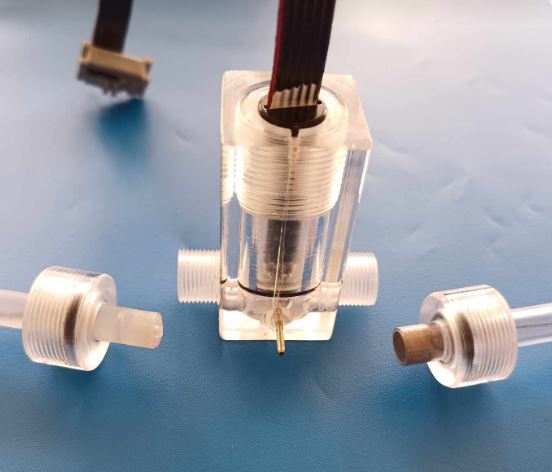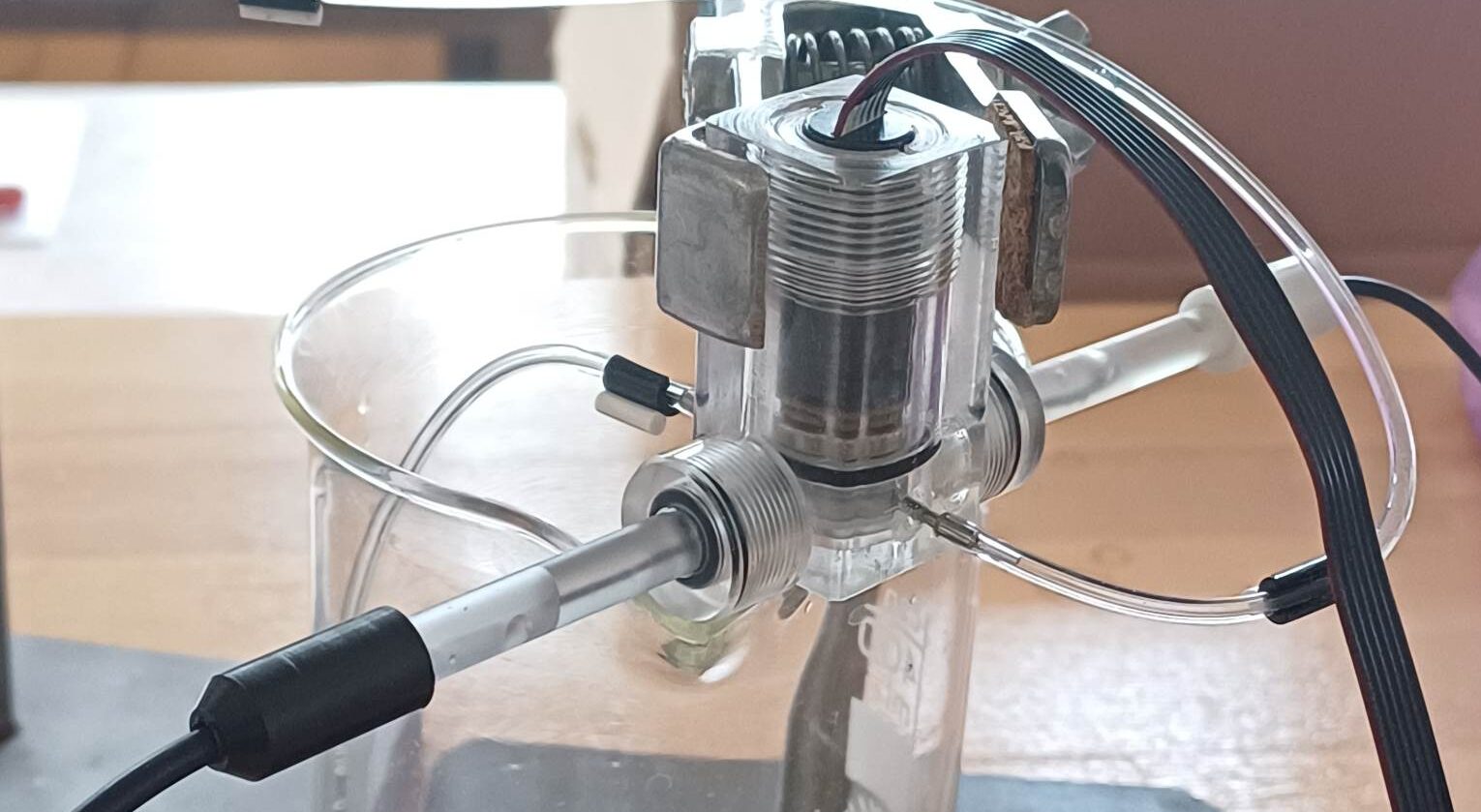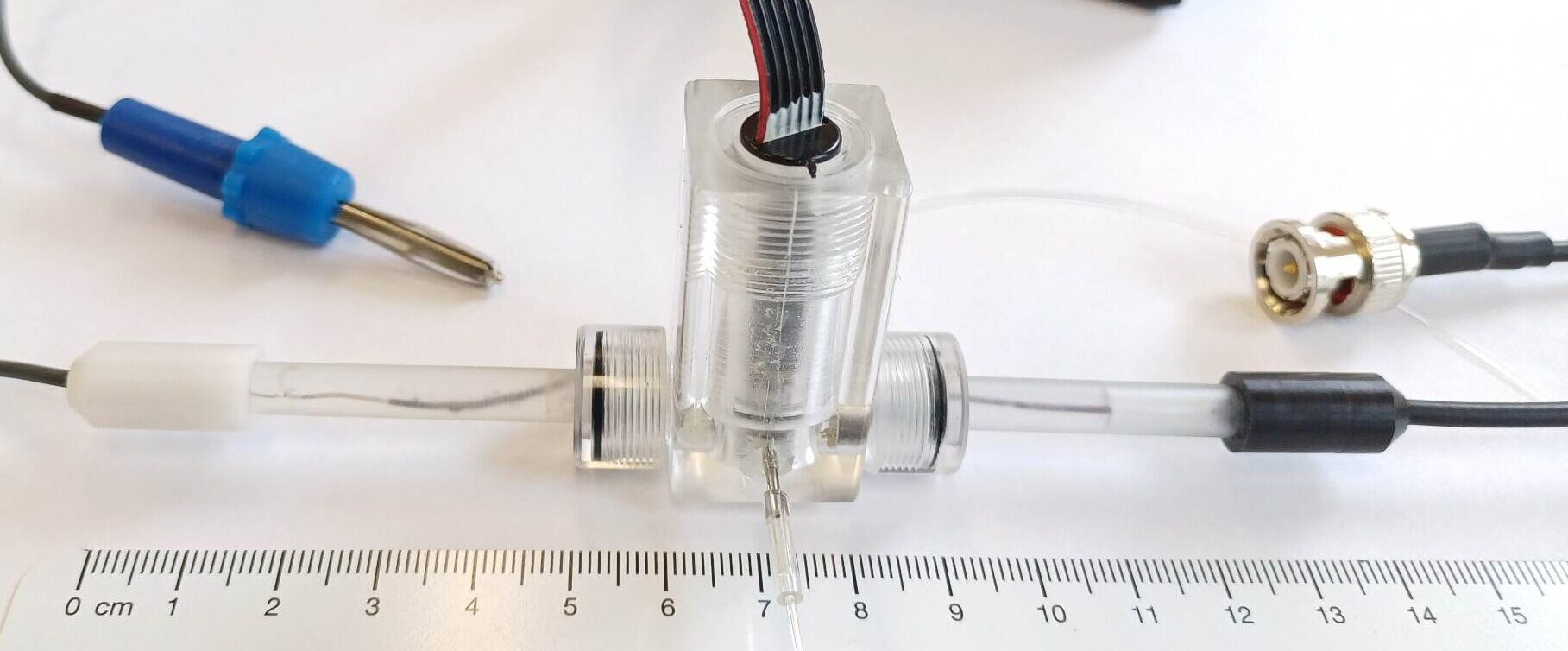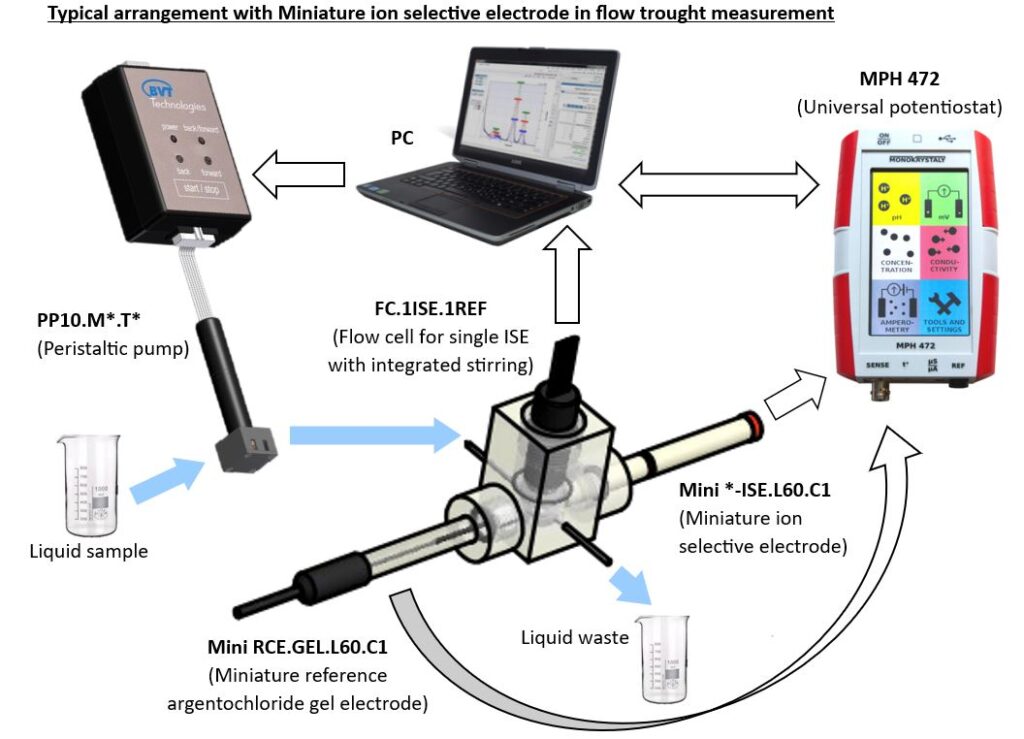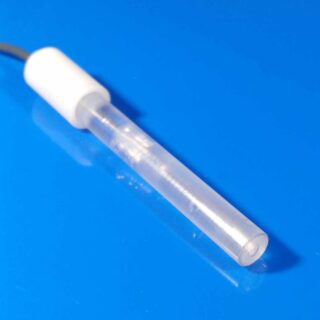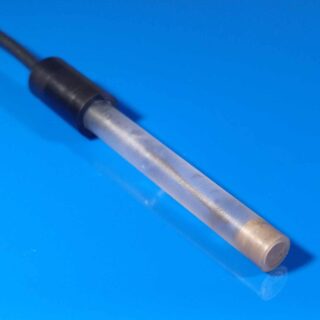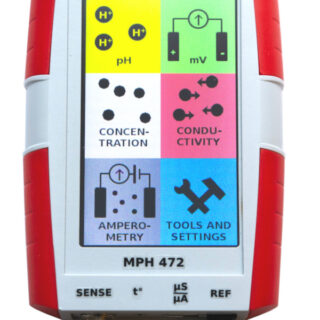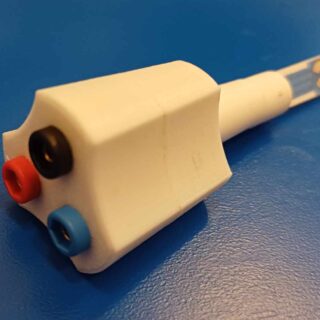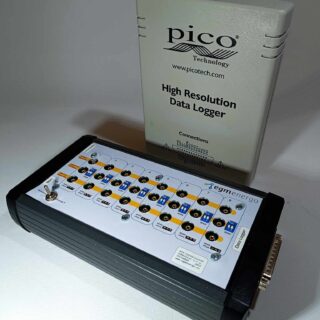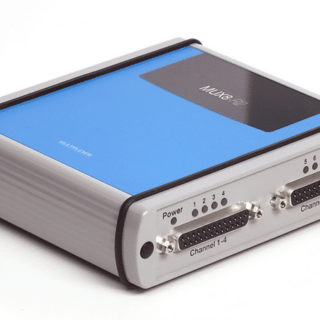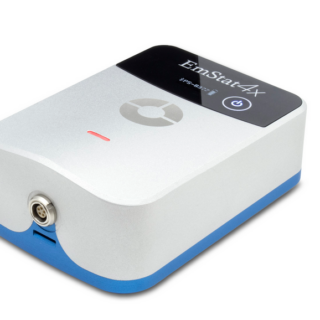Category
- Custom made glass products
- CUSTOMER SERVICES
- NEW PRODUCTS
- Sensors and electrodes
- Custom made and Modified Screen Printed Electrodes
- Stirrers
- Cables and connectors
- Cell
- Potentiostats
- Manual Screen Printer
- Minithermostat
- Pumps
- Accessories
- Kits & Sets
- Discounted SPEs (at a reduced price with visual defects/inconsistancies, but fully functional)
FC.1ISE.1REF Flow cell for single ion selective electrode with integrated stirring
The flow cell with integrated stirring and reduced hydrodynamic noise is designed for the determination of single analyte using one miniature ion-selective electrode (ISE) and one miniature reference electrode with a diameter of 6 mm and length of 60 mm.
Rotation speed of integrated stirrer: 10-4000 rmp.
Miniature ion-selective electrodes and reference electrode were designed for integration into the flow cell for determination of Cl-, K+, Ca2+ and Na+ ions.
In flow mode, the system can operate automatically. The speed of the integrated stirrer can also be controlled by applying the corresponding voltage to the motor, connected to a stabilized source.
The flow cell with one selected ISE can be used for:
- Automatic or semi-automatic measurement of concentration of Cl-, K+, Ca2+ and Na+ ions in various solutions (following prior calibration)
- For continuous measurement of changes in concentration of Cl-, K+, Ca2+ and Na+ ions.
* For this product, we recommend our customers use the Training Service from BVT.
(https://bvt.cz/produkt/offer-of-long-term-automated-measurements-on-bvt-apparatus/)
You may also like…
-
Mini RCE.GEL.L60.C1 Miniature reference argentochloride gel electrode
Read moreMiniature reference argentochloride gel electrode is designed for potentiometric measurements in connection with Miniature ion selective electrodes for potentiometric measurements of Chloride ions, Sodium ions, Calcium and Potassium ions concentration in aqueous solutions following prior calibration.
The conductive connection of the internal electrolyte (KCl gel) enclosed in a plastic tube is mediated by a porous frit.
Maintenance-free electrode – no need to top up the internal electrolyte (KCl gel).
Electrodes are applicable to all commonly used measuring apparatus, with input resistance of at least 1012 Ω.
Possibility of integration with a FC.1ISE.1REF Flow cell for single ion selective electrode with integrated stirring – possible automation and continuous measurement.
-
Mini *-ISE-L60.C* Miniature ion selective elecrodes
Read moreMiniature ion selective electrodes for potentiometric measurements of Chloride ions, Sodium ions, Calcium and Potassium ions concentration in aqueous solutions when used together with a reference electrode (following prior calibration) with a diameter of 6 mm and a length of 60 mm.
Specifically, these applications may include analyses for agricultural purposes, online monitoring of the representation of selected ions in water management, certain industrial areas or agriculture (hydroponic cultivation of plants) etc.
Electrodes are applicable to all commonly used measuring apparatus, with input resistance of at least 1012 Ω. The work with ion selective electrodes is time effective, requires an only small amount of chemicals, and a friendly price of measuring equipment (potentiostat with measuring method potentiometry).
Possibility of integration with a FC.1ISE.1REF Flow cell for single ion selective electrode with integrated stirring – possible automation and continuous measurement.
* For this product, we recommend our customers use the Training Service from BVT.
(https://bvt.cz/produkt/offer-of-long-term-automated-measurements-on-bvt-apparatus/)
-
MPH 472 Universal Potentiostat
Read moreThe instrument enables measurement of amperometry, potentiometry and conductometry. Communication with the computer is provided via USB or Bluetooth. This hand-held device is equipped with GPS navigation so the measured data may be enhanced by the exact coordinates of the location where the measurement was made.
Measured data can be stored and later processed in a PC because of the SD card slot incorporation. The ability to record a waveforms or integrate the measure values is enabled. Basic evaluation methods are also implemented – linear and non-linear calibration and standard addition method is available. The influence of the type of oxygen electrode membrane, temperature or gas solubility can be compensated for the measured values.
The measured data are automatically recalculated and displayed in units of current, voltage, concentration (g∙L-1 or mol∙L-1) or saturation. Potentiometric measurement allows connection of pH electrodes and ISE.
Key Properties
- Up to 200 hours of battery life depending on the operating mode.
- Excellent analytical tools (graphs, unit conversions, internal standard method for potentiometry, coulometric titration, 10 Henry’s constants for various redox active gases).
- Power supply and data communication via USB, possibility of connection via Bluetooth.
- Data logging to memory card.
- Up to 5-point calibration for ISE and pH electrodes.
- Up to 4-point calibration of the conductivity cell makes it possible to compensate the non-linearity of the measurement.
- GPS equipment enables measurements in the field with location storage.
- Calibration stored separately in the device (possibility of changing the memory card without having to recalibrate the device).
- Possibility of separate calibration for 4 probes for amperometry and potentiometry.
- The possibility of using different temperature sensors (PT100, PT1000, Ni1000, ATC Monocrystals).
- Advanced power management (display sleep and automatic device shutdown can be set according to the user’s preferences
- Vector voltmeter for accurate conductivity measurement.
- Powerful thirty-two-bit microprocessor for accurate measurement calculations.
Improvements:
- Faster battery charging via USB charger.
- Vector voltmeter for precise conductometric measurement.
- A more sensitive GPS module.
- More robust input circuits for ametrometric measurement – less susceptible to noise.
More information can be found through the link: https://www.monokrystaly.cz/cs/ph-mv-ion-metry.html?fbclid=IwAR3ieir-mH-D10LZ-SZkrx74OHZYvOHjZPnOX8nfi9WdcwostsUgTAVaZPM#MPH471
Related products
-
SPE Connector.GC.1 for measurements in glass
Read moreThe connector enables the use of the biosensor or electrochemical sensor based on the substrates AC1, AC4 and TS1 in glass cell TC4, TC5, TC6 or TC7.
The connector enables measurement with screen printed electrodes with width 7.26 mm and standard contact pads pitch (2.54 mm).
It is compatible with other SPE´s that use the same distance between the contact pads (2.54 mm). The cone at the connector sensor side is NJ 8/10 which enables to use the connector with any standard chemical vessels.Termination: 2 mm Banana plugs
-
8/16-Channel Potentiostat for High Resolution Data Logger
Read moreThe device consists of a combination of an multi-channel potentiostat/converter (BVT Technologies) and an external USB Pico ADC high resolution data logger (Pico Technology).
The data logger can be supplied in two versions: ADC-20 (20 bits, 8 channels) or ADC-24 (24 bits, 16 channels). For detailed specifications, see the attachment at the end of the document. The device allows measurements from up to 8 or from up to 16 independent channels. The basic output signal is a voltage in the range of -2.5 to 2.5 V. All channels are programmable (the output can be concentration, temperature, pressure…).
After connecting the device to a PC with Pico Technology’s Picolog 6 measurement program installed, the voltage [V] can be processed using math channels and directly recorded in real time as temperature, current, resistance, frequency, % and pressure, see measurement example at the end of the document.
For temperature measurement, the device is compatible with resistance thermometers (Ni 1000, Ni 5000, Pt 1000. Power is provided via USB-B, the maximum electrical consumption of the device is 500 mA.
Device Usage
- Temperature measurement with different temperature sensor (resistance thermometers Ni 1000, ni 5000, Pt 1000)
- Voltage measurement
- Conductivity and resistance measurement
- Amperometry measurement
* For this product, we recommend our customers use the Training Service from BVT.
(https://bvt.cz/produkt/offer-of-long-term-automated-measurements-on-bvt-apparatus/)
-
MUX8-R2 Multiplexer
Read moreMultiplexer for 8 up to 128 cells
- Automatically switch between electrochemical cells
- Easy stacking with magnetic feet and top
- 4 different electrode or sensor configurations
- Daisy chain multiplexers, up to 128 channels!
The PalmSens series and the EmStat4X can be used to work with multiple working electrodes or a sensor array by means of a multiplexer.
The multiplexer switches between the working electrodes in the range of milliseconds.
- each MUX8-R2 multiplexer enables to work with up to eight 2- or 3- electrode systems.
- daisy chaining multiple MUX8-R2 boards (expansion up to 128 channels)
- all hardware settings are controlled by the software making it unnecessary to flick a physical switch
- LEDs to show which channel is selected
- allows to connect auxiliary input (like temperature sensor)
More information can be found through the link: https://www.palmsens.com/product/mux8-r2/
Connection options
The most selected connection option uses two double shielded D-Sub cables ending in 2 mm banana plugs. As alternatives we can provide a PCB with screw terminals, D-Sub cable ending in ferrules or Screen Printed Electrode Adapter. Each of these cables can be connected to 4 channels, if all 8 channels are used, two cables are needed.
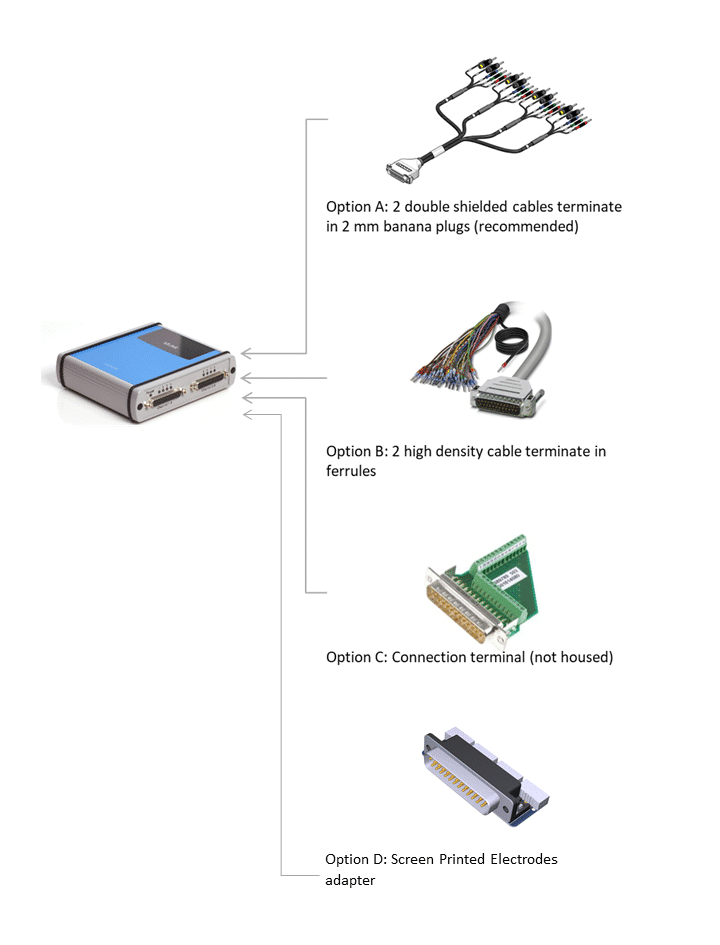
Specifications
System number of channels 8 (up to 128 when daisy chained) multiplexer switches 8 x (WE, S, RE and CE) on resistance for WE 1.5 ohm typical charge injection on WE 20 pC typical leakage current < 55 pA (30 pA typical) at 25 ºC switching time 2 ms compliance voltage
± 10 V Other housing aluminium: 138 mm x 121 mm x 37 mm weight +/- 500 g temperature range 0 ºC to + 50 ºC power supply USB The MUX8-R2 has the following connectors:
Connector Function Input Y-cable connects to both potentiostat sensor connector and (digital) AUX AUX Can be used to measure auxiliary input like temperature or pH, and to switch external hardware using two digital control lines that can be set in PSTrace Link Connects to Input of next multiplexer, for daisy-chaining multiple multiplexers USB-C Input for extra power when
≥3 multiplexers are daisy-chainedChannel 1-4 Connects to sensor cables 1-4 Channel 5-8 Connects to sensor cables 5-8 -
EmStat4X
Read moreThe EmStat4X delivers high performance in a small footprint. The EmStat4X is a small battery and USB-powered Potentiostat, Galvanostat, and optional Frequency Response Analyser (FRA) for Electrochemical Impedance Spectroscopy (EIS).
The EmStat4X Low Range (LR) version is great for applications that require measuring low currents down to picoamps, like (bio)sensor research. The High Range (HR) version is very suitable for applications that need a maximum current of up to 200 mA. The EmStat4X is controlled with PSTrace for Windows, or you can write your own MethodSCRIPT and control it from any platform or operating system.
More information can be found through the link: https://www.palmsens.com/product/emstat4s/
The EmStat4X LR and HR features include:
- Fast EIS support: for running fixed-frequency EIS measurements at a very low interval of around 1 ms.

- Auxiliary Port: for connecting to a MUX8-R2 multiplexer, temperature sensor, pH sensor, stirrer control, triggering and more.
- iR compensation: to compensate for the iR drop between the Reference electrode and the outside of the double layer of the electrochemical cell.
- Bluetooth: for a wireless connection to a PC, smartphone or tablet
- 11.1 Wh battery: for more than 8 hours of continuous measurements (typical with the LR).
- Small borderless display: showing the state of the battery and connectivity.
Two versions
The EmStat4X comes in two different versions:
- Low Range: for lower currents and potentials (±30 mA / ±3 V applied / ±5 V compliance)
- High Range: for higher currents and potentials (±200 mA / ±6 V applied / ±8 V compliance)
Both versions can be configured with optional EIS/FRA up to 200 kHz.
See specifications for a detailed comparison between the LR and HR.Always a backup
The EmStat4X is equipped with 500 MB internal storage memory for storing your measurements as a backup. All internally stored measurements can be browsed and transferred back to the PC easily using the PSTrace software for Windows. Your data is always with your instrument wherever you take it.
Standard included
A standard EmStat4X includes a rugged carrying case with:
- EmStat4X LR or HR
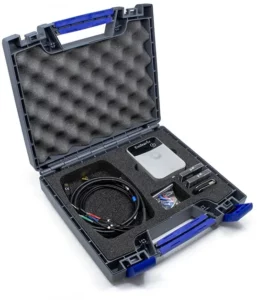
- USB-C cable
- Cell cable: high quality, double-shielded cable with 2 mm banana connectors for Working, Counter, Reference electrode and Ground, 1 meter long
- 4 or 5 crocodile clips
- Dummy Cell
Also included:
- PSTrace software for Windows (on USB drive)
- Manual (hardcopy)
- Quick Start (hardcopy)
- Calibration report
- Fast EIS support: for running fixed-frequency EIS measurements at a very low interval of around 1 ms.

